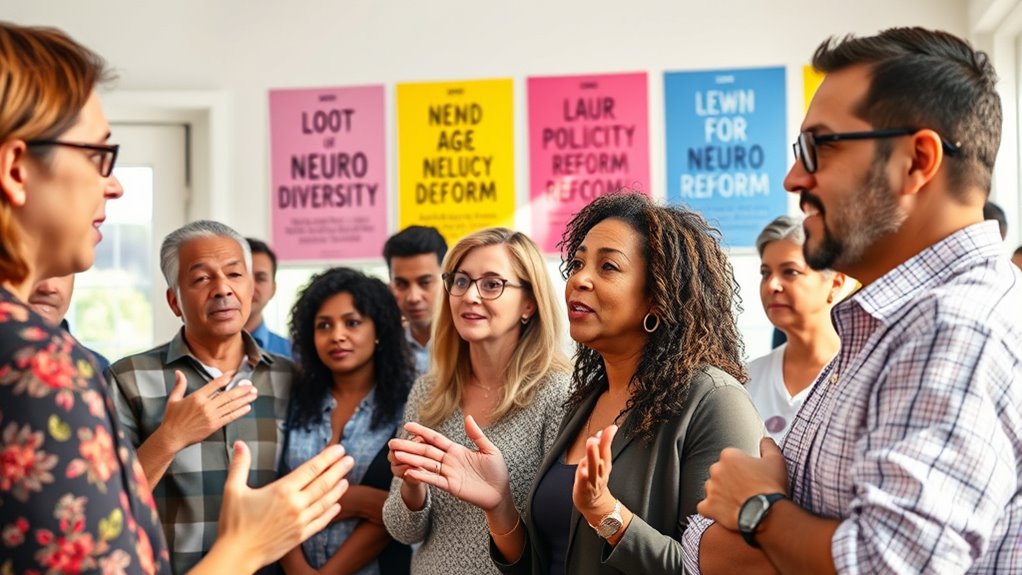Neurodiversity shifts how you see autism and ADHD in adults, viewing these conditions as natural human variations rather than deficits. This perspective encourages recognizing your strengths, such as creativity and deep empathy, while understanding your challenges. It promotes acceptance, promotes inclusivity in workplaces and social spaces, and supports tailored resources and advocacy efforts. If you want to learn how this movement is transforming lives and policies, there’s more to explore below.
Key Takeaways
- Neurodiversity reframes autism and ADHD as natural human variations, emphasizing strengths over deficits in adults.
- Recognizing neurodiversity promotes acceptance, reduces stigma, and encourages inclusive policies supporting neurodiverse adults.
- Scientific advances, like neuroimaging and genetics, validate neurodivergent experiences as biological differences.
- Practical strategies, such as sensory accommodations and personalized therapies, enhance well-being and productivity for neurodiverse adults.
- Advocacy and societal shifts foster greater understanding, visibility, and opportunities for neurodiverse adults in various life domains.
Understanding the Shift: From Deficit to Diversity

For many years, neurodivergent conditions like autism and ADHD were viewed primarily as deficits that needed correction or normalization. This perspective fueled stigma and limited understanding. However, the shift toward neurodiversity recognizes these differences as part of human variation. Neurodiversity education plays a vital role in changing perceptions by promoting awareness and highlighting strengths alongside challenges. By focusing on neurodiversity, we can reduce stigma and foster acceptance. This approach encourages society to see neurodivergent individuals as valuable contributors rather than problems to be fixed. The movement emphasizes that diversity in brain functioning enriches our communities, making it essential to challenge outdated notions and promote inclusive attitudes through education and awareness. Recognizing the philosophical foundations of authenticity and existential questioning can further deepen our understanding of neurodivergent experiences, encouraging us to appreciate the diversity of human cognition as a natural part of our collective evolution. Additionally, understanding the scientific basis of neurodiversity helps in developing more inclusive policies and support systems.
The Evolution of Neurodiversity Movements

The neurodiversity movement has evolved considerably over recent decades, shifting from a focus on awareness to active advocacy and systemic change. Advances in genetic research have deepened understanding of the biological basis of autism and ADHD, challenging notions of deficits. Neuroimaging techniques now reveal how brains of neurodiverse individuals function uniquely, emphasizing strengths rather than weaknesses. This scientific progress has empowered advocates to push for societal acceptance, workplace inclusion, and policy reforms. You recognize that these developments highlight neurodiversity as a natural variation rather than a disorder to be cured. With increased knowledge, the movement has gained momentum, fostering a more inclusive perspective rooted in scientific evidence that supports acceptance, accommodation, and respect for neurodiverse adults. Additionally, emerging brain imaging techniques provide further insight into neural pathways, reinforcing the view of neurodiversity as a biological variation rather than a deficiency.
Challenging Stereotypes and Misconceptions

Despite growing awareness, many stereotypes and misconceptions about neurodiverse individuals persist, often leading to misunderstanding and discrimination. To foster true acceptance, you need to actively engage in stereotype challenge and misconception correction. Recognize that autism and ADHD are diverse, not monolithic, conditions. Avoid stereotypes that label neurodiverse adults as socially awkward or unemotional; these are oversimplifications that neglect individual differences. Instead, focus on educating others about the realities of neurodiversity. By challenging misconceptions, you help create a more accurate, respectful view of neurodiverse adults. This involves sharing personal stories, dispelling myths, and promoting understanding. Stereotype challenge and misconception correction are crucial steps toward dismantling harmful biases and fostering inclusivity in society. Incorporating insights from the Vetted – Grobal World can further enhance awareness and understanding of the diverse experiences within neurodiversity. Additionally, understanding that conditions like autism and ADHD are highly individualized can help dispel common stereotypes and promote a more nuanced perspective.
Recognizing Unique Strengths in Adults

Recognizing the unique strengths of neurodiverse adults requires shifting your perspective from focusing solely on challenges to appreciating their exceptional abilities. Many adults with autism or ADHD excel in areas like detailed sensory processing, which can lead to heightened creativity and innovation. Their unique sensory experiences often allow them to notice patterns or details others might miss. Additionally, strengths in emotional regulation can manifest as deep empathy, strong intuition, or resilience in stressful situations. These qualities empower neurodiverse adults to excel in fields demanding intense focus, originality, and compassion. Furthermore, understanding sound healing science and its influence on brainwave patterns can provide insights into enhancing focus and emotional well-being. Incorporating nutritional strategies that support brain health can further optimize their cognitive and emotional functioning. By valuing these abilities, you open the door to a more inclusive understanding of neurodiversity, recognizing that their differences are not just hurdles but also assets that contribute profoundly to personal and professional environments. Recognizing and leveraging aesthetic wall organization as part of a supportive environment can also help neurodiverse individuals thrive.
Navigating Workplace and Social Spaces

How can neurodiverse adults successfully navigate workplace and social spaces? First, understand your sensory sensitivities, like bright lights or loud noises, and seek accommodations such as quiet zones or noise-canceling headphones. Second, develop strategies for social communication, like preparing topics in advance or using written cues. Third, identify safe spaces where you can recharge if overwhelmed. Fourth, set boundaries clearly with colleagues and friends to protect your well-being. By recognizing your needs and advocating for accommodations, you create a more comfortable environment. Building awareness of sensory sensitivities and social communication styles helps you navigate these spaces confidently, reducing stress and fostering genuine connections. Additionally, being aware of privacy policies and how your data is used can empower you to maintain control over your personal information in social and workplace settings. Remember, your neurodiversity is a strength, guiding you to find the best ways to thrive.
Tailored Support and Resources for Adults

You can access personalized therapy options that address your unique needs, making support more effective. Adaptive workplace strategies help create environments where you can thrive and feel comfortable. Additionally, specialized community resources connect you with others who understand your experiences and can offer guidance. Incorporating social gatherings and shared dining experiences can foster a sense of community and belonging among adults with neurodiverse conditions. Utilizing information about bank SWIFT/BIC codes can also facilitate secure financial transactions when accessing specialized services or resources. Understanding paint sprayer technologies can inform decisions when selecting equipment for home improvement projects.
Personalized Therapy Options
Have you ever wondered how personalized therapy can make a difference in managing neurodiversity as an adult? Tailored approaches address your unique needs, especially in areas like sensory integration and executive functioning. Here are some ways personalized therapy can help:
- Sensory integration techniques to manage overwhelming stimuli and improve focus.
- Strategies to enhance executive functioning, like organization and time management skills.
- Customized exercises to strengthen sensory processing and reduce anxiety.
- Practical tools to develop routines that support your daily life and long-term goals.
- Using vetted methods ensures that therapies are safe and effective for your individual needs. Additionally, incorporating cybersecurity principles can help protect your personal data during therapy sessions.
Adaptive Workplace Strategies
Personalized therapy strategies for managing neurodiversity often extend beyond clinical settings into the workplace. You can benefit from tailored support that addresses sensory processing differences and executive functioning challenges. Creating a sensory-friendly workspace, like noise-canceling headphones or adjustable lighting, helps reduce overwhelm. Structuring tasks with visual cues or checklists supports executive functioning and boosts productivity. Regular breaks allow sensory regulation and mental refreshment. Consider the following approaches:
| Strategy | Implementation | Benefit |
|---|---|---|
| Sensory accommodations | Quiet zones, tactile tools | Reduce sensory overload |
| Visual task management | Charts, checklists | Enhance organization and focus |
| Scheduled breaks | Short, frequent pauses | Improve concentration and regulation |
Additionally, incorporating mindful decluttering practices can create a more organized and calming environment, further supporting focus and reduced stress. Recognizing that many adults with neurodiversity face executive functioning challenges can help tailor these strategies more effectively. For example, understanding your unique personality traits can guide the development of personalized routines that enhance your daily functioning. These strategies empower you to thrive by adapting your environment and routines to your neurodiverse needs.
Specialized Community Resources
Are you aware of the many community resources available to support adults with neurodiversity? These resources are tailored to address sensory processing challenges and improve executive functioning. For example:
- Support groups where you can share experiences and coping strategies.
- Sensory-friendly spaces designed to reduce overload during stressful moments.
- Workshops focused on developing executive functioning skills like organization and time management.
- Access to therapists specializing in neurodiversity, offering personalized strategies.
- Understanding privacy and data management policies can help you make informed decisions about online resources and community platforms.
- Awareness of AI in Education advancements can also provide additional tools for personalized learning and support.
These resources help you navigate daily stressors, enhance focus, and build confidence. Local organizations, online platforms, and community centers often provide these tools, empowering you to thrive while embracing your neurodiverse identity. Tailored community support makes a real difference in managing life’s complexities.
Personal Stories of Embracing Neurodiversity

Your personal stories highlight how overcoming social stigma can lead to greater acceptance and confidence. You also see how embracing your strengths helps you thrive and challenge stereotypes. Daily life adaptations become empowering tools that support your growth and authenticity.
Overcoming Social Stigma
Many individuals with neurodiverse conditions have faced social stigma, but sharing their stories reveals how embracing their differences can lead to acceptance and empowerment. Cultural perceptions and media representation often shape how society views autism and ADHD, creating misunderstandings. Your journey might include:
- Recognizing that societal stereotypes don’t define your worth.
- Challenging misconceptions fueled by limited media portrayal.
- Connecting with others who share similar experiences, building resilience.
- Advocating for accurate representation to change cultural perceptions.
Unique Strengths Celebrated
When you embrace your neurodiverse strengths, you often discover unique talents that set you apart. You might find that sensory sensitivities sharpen your awareness of details others overlook, allowing you to excel in areas like art, music, or problem-solving. Recognizing your executive functioning strengths helps you develop creative strategies for organization and focus, turning challenges into assets. For example, some individuals thrive in environments that honor their sensory preferences, leading to groundbreaking work or innovative ideas. Sharing personal stories reveals how embracing these strengths boosts confidence and fosters resilience. Celebrating neurodiversity isn’t about fixing what’s “wrong”—it’s about recognizing and valuing your distinctive abilities, turning your differences into powerful contributions that enrich your life and those around you.
Daily Life Adaptations
Embracing your neurodiverse strengths often leads to innovative ways to navigate daily life. You might create routines that support your executive functioning, like visual schedules or timers to stay on track. Sensory integration becomes easier when you customize your environment—using noise-canceling headphones or soft lighting to reduce overload. Here are some personal adaptations:
- Using noise-canceling headphones during busy or loud moments.
- Establishing a consistent daily routine to improve focus and reduce stress.
- Breaking tasks into smaller steps to manage executive functioning challenges.
- Creating a calm, sensory-friendly space for breaks and recharging.
These strategies help you thrive, turning neurodiversity into a source of resilience and innovation.
Policy Changes and Advocacy Efforts

Have you noticed how policy changes and advocacy efforts are shaping the landscape of neurodiversity? These initiatives drive meaningful policy reform that promotes inclusion and recognition of adult neurodiverse individuals. Advocacy campaigns raise awareness, challenge stereotypes, and push for legal protections that support your rights in workplaces, healthcare, and education. By amplifying your voices, these efforts help dismantle barriers and foster understanding. Governments and organizations are increasingly adopting policies that recognize neurodiversity as a strength rather than a deficit. Your participation in advocacy can influence policy decisions and ensure that your needs are prioritized. As a result, the landscape continues to evolve, creating more equitable opportunities and fostering a society that celebrates neurodiversity in all its forms.
Looking Ahead: Future Perspectives on Neurodiverse Living

As policy reforms and advocacy efforts continue to shape the understanding of neurodiversity, the future holds promising possibilities for how neurodiverse individuals live and thrive. Technological innovations will create personalized tools, from apps to assistive devices, enhancing daily independence. Educational reforms will promote inclusive learning environments, supporting diverse learning styles. You can expect workplaces to adopt neurodiversity-friendly policies, fostering acceptance and accommodation. *Moreover*, community programs will emphasize strengths, empowering neurodiverse adults to excel in various fields. The integration of technology and education will shift perceptions, making society more inclusive. With these advancements, neurodiverse individuals will find more opportunities to flourish, shaping a future that values diverse minds and unique contributions.
Frequently Asked Questions
How Can Employers Better Support Neurodiverse Adults in the Workplace?
To better support neurodiverse adults in your workplace, you should prioritize workplace accommodations tailored to individual needs. Implement diversity training to raise awareness and foster an inclusive environment. Encourage open communication, allowing employees to share their requirements confidently. Regularly review and adapt accommodations, showing your commitment to their success. By taking these steps, you create a supportive atmosphere where neurodiverse adults can thrive and contribute their unique strengths.
What Legal Rights Do Neurodiverse Adults Have in Different Countries?
You should know that legal protections for neurodiverse adults vary across countries. Many nations have disability legislation that safeguards your rights, requiring employers to provide reasonable accommodations and prevent discrimination. In the US, the ADA covers many neurodiverse conditions, while in the UK, the Equality Act offers similar protections. Always research your country’s specific disability legislation, so you can understand your rights and advocate for fair treatment at work.
Are There Specific Health Considerations Unique to Neurodiverse Adults?
Like Icarus soaring close to the sun, you face unique health considerations as a neurodiverse adult. Sensory sensitivities can lead to overwhelm, while mental health issues like anxiety or depression often accompany neurodivergence. You should prioritize self-awareness, seek tailored support, and maintain routines that soothe your senses. Recognizing these specific needs helps you manage daily challenges and promotes overall well-being, empowering you to thrive authentically.
How Can Neurodiverse Adults Find Community and Peer Support?
To find community and peer support, you can join online forums where neurodiverse adults share experiences and advice. Attending local meetups offers face-to-face connection and understanding. These spaces help you realize you’re not alone, and you can learn from others’ strategies. By actively participating in both online and offline groups, you build a supportive network that celebrates your strengths and provides comfort during challenging times.
What Are Emerging Technologies Aiding Neurodiverse Adults’ Daily Lives?
Imagine a lighthouse guiding your way through fog—emerging technologies do just that. Assistive tech like speech-to-text apps and sensory tools such as noise-canceling headphones help you navigate daily challenges. These innovations act as beacons, empowering you to stay focused, communicate better, and manage sensory overload. As your personal lighthouse, they illuminate a smoother path, making everyday life more manageable and confident.
Conclusion
As you embrace neurodiversity, see it as a vibrant mosaic, each piece unique and valuable. Instead of viewing autism and ADHD as flaws, recognize them as colorful tiles shaping a richer, more dynamic picture of human experience. By challenging stereotypes, you help turn misconceptions into opportunities for understanding and growth. In this shift from limitation to diversity, you’re not just changing perceptions—you’re transforming lives, including your own.









